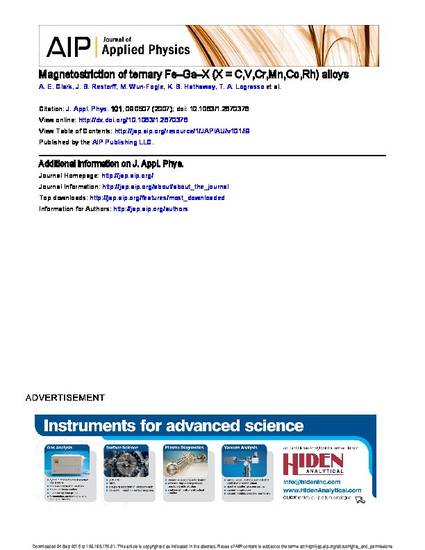
Presentation
Magnetostriction of ternary Fe–Ga–X (X = C,V,Cr,Mn,Co,Rh) alloys
Ames Laboratory Conference Papers, Posters, and Presentations
Document Type
Conference Proceeding
Disciplines
Conference
10th Joint MMM–Intermag Conference
Publication Date
4-20-2007
Geolocation
(39.2903848, -76.61218930000001)
Abstract
Binary iron-gallium (Galfenol) alloys have large magnetostrictions over a wide temperature range. Single crystal measurements show that additions of 2 at. % or greater of 3d and 4d transition elements with fewer (V, Cr, Mo, Mn) and more (Co, Ni, Rh) valence electrons than Fe, all reduce the saturation magnetostriction. Kawamiya and Adachi [J. Magn. Magn. Mater. 31–34, 145 (1983)] reported that the D03 structure is stabilized by 3dtransition elements with electron∕atom ratios both less than iron and greater than iron. IfD03 ordering decreases the magnetostriction, the maximum magnetostriction should be largest for the (more disordered) binary Fe–Ga alloys as observed. Notably, addition of small amounts of C (0.07, 0.08, and 0.14 at. %) increases the magnetostriction of the slow cooled binary alloy to values comparable to the rapidly quenched alloy. We assume that small atom (C, B, N) additions enter interstitially and inhibit ordering, thus maximizing the magnetostriction without quenching.
Copyright Owner
American Institute of Physics
Copyright Date
2007
Language
en
Citation Information
A. E. Clark, J. B. Restorff, M. Wun-Fogle, K. B. Hathaway, et al.. "Magnetostriction of ternary Fe–Ga–X (X = C,V,Cr,Mn,Co,Rh) alloys" Baltimore, MD(2007) Available at: http://works.bepress.com/thomas_lograsso/87/

The following article appeared in Journal of Applied Physics 101 (2007): 09C507 and may be found at http://dx.doi.org/10.1063/1.2670376.